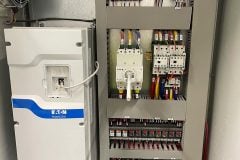Reducing Operating Costs
Using premium efficiency motors can reduce your operating costs in several ways. Not only does saving energy reduce your monthly electrical bill, it can postpone or eliminate the need to expand the electrical supply system capacity within your facility.

On a larger scale, installing efficiency measures allows electrical utilities to defer building expensive new generating plants, resulting in lower costs for all consumers.
Saving energy and money begins with the proper selection and use of premium efficiency motors.
After obtaining readily available information such as motor nameplate data, annual operating hours, and electrical rates, you can quickly determine the simple payback that would result from investing in and operating a premium efficiency motor.

Oportunities
The following circumstances are opportunities for choosing premium efficiency motors:
- When purchasing a new motor in horsepower and speed ratings where energy efficient units can still be sold
- Instead of rewinding failed standard efficiency or energy efficient motors
- To replace an operable but inefficient motor for greater energy savings and reliability.
Instances
Premium efficiency motors should be specified in the following instances:
- For all new installations
- When major modifications are made to existing facilities or processes
- For all new purchases of original equipment manufacturer (OEM) products that contain electric motors
- When purchasing spares
- As economically justified replacements for failed standard efficiency or energy efficient general purpose motors that would otherwise be rewound
- To replace oversized and underloaded motors (consider downsizing when a motor is operating at less than 40% of its rated output)
- When accelerated standard efficiency motor replacement is part of an energy management plan or preventive maintenance program
- When utility conservation programs, rebates, or incentives are offered that make premium efficiency motor retrofits immediately cost-effective.
Monterrey AC capabilities (VIDEO)
Reference: Premium efficiency motor selection and application guide – U.S. Department of Energy’s Office of Energy Efficiency and Renewable Energy











Dear Edvar,
I’m a civil engineer, not an EE but I do have to cope with fluctuations, low voltages, very high surges that burn appliances and electronic equipment in my home town. Could we collaborate on finding cheap solutions to communities or at least direct me to the path to be taken, specific articles, success model town, cities or communities that overcome that kind of problem. Probably, neither you nor I have the financial means to achieve such endeavor but, by getting others involved we can certainly reach new heights and provide hope where despair rules the lives of so many people.
Good information. but Energy efficient motors should be used in new project or new line of operation. If you are going to replace some new energy efficient motors specially for pump or fan application, then one must look after the operating speed of the fan/pump. because we know that the rated speed of energy efficient motors is more than the std. efficiency motor. We know that for variable torque application P ~ N^3. So, if the BKW of the fan is 25, speed of the old motor is 1470 rpm & the new motor 1488 rpm. So the power demand is 25 X (1488/1470)^3= 26KW. So, instead of saving the energy, input power demand will be increase. So in case of replacement, one must change the belt pulley ratio to maintain the speed or trim the impeller of the pump.
Good information.
Thank you Biju.
In the matter of fact, there are few other things to check and to try to optimize to get better efficiency (to check belts, gearbox etc.). It’s always about cost. If the cost is justified by purchasing of premium efficiency motor – then it’s ok.